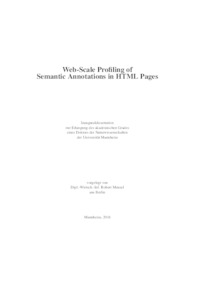|
Web-scale profiling of semantic annotations in HTML pages
Meusel, Robert
![[img]](https://madoc.bib.uni-mannheim.de/41884/1.hassmallThumbnailVersion/thesis_final_rm_20170322-1.pdf)  Vorschau |
|
PDF
thesis_final_rm_20170322-1.pdf
- Veröffentlichte Version
Download (4MB)
|
|
URL:
|
https://madoc.bib.uni-mannheim.de/41884
|
|
URN:
|
urn:nbn:de:bsz:180-madoc-418842
|
|
Dokumenttyp:
|
Dissertation
|
|
Erscheinungsjahr:
|
2017
|
|
Ort der Veröffentlichung:
|
Mannheim
|
|
Hochschule:
|
Universität Mannheim
|
|
Gutachter:
|
Bizer, Christian
|
|
Datum der mündl. Prüfung:
|
10 März 2017
|
|
Sprache der Veröffentlichung:
|
Englisch
|
|
Einrichtung:
|
Fakultät für Wirtschaftsinformatik und Wirtschaftsmathematik > Information Systems V: Web-based Systems (Bizer 2012-)
|
|
Fachgebiet:
|
004 Informatik
|
|
Normierte Schlagwörter (SWD):
|
Data-Profiling
|
|
Freie Schlagwörter (Englisch):
|
Dataspace Profiling , RDFa , Microformats , Microdata , Schema.org , Crawling
|
|
Abstract:
|
The vision of the Semantic Web was coined by Tim Berners-Lee almost two decades
ago. The idea describes an extension of the existing Web in which “information
is given well-defined meaning, better enabling computers and people to work in
cooperation” [Berners-Lee et al., 2001].
Semantic annotations in HTML pages are one realization of this vision which
was adopted by large numbers of web sites in the last years. Semantic annotations
are integrated into the code of HTML pages using one of the three markup languages
Microformats, RDFa, or Microdata. Major consumers of semantic annotations are
the search engine companies Bing, Google, Yahoo!, and Yandex. They use semantic
annotations from crawled web pages to enrich the presentation of search results and
to complement their knowledge bases.
However, outside the large search engine companies, little is known about
the deployment of semantic annotations: How many web sites deploy semantic
annotations? What are the topics covered by semantic annotations? How detailed
are the annotations? Do web sites use semantic annotations correctly? Are semantic
annotations useful for others than the search engine companies? And how can
semantic annotations be gathered from the Web in that case?
The thesis answers these questions by profiling the web-wide deployment of
semantic annotations.
The topic is approached in three consecutive steps: In the first step, two approaches
for extracting semantic annotations from the Web are discussed. The thesis
evaluates first the technique of focused crawling for harvesting semantic annotations.
Afterward, a framework to extract semantic annotations from existing web crawl
corpora is described. The two extraction approaches are then compared for the
purpose of analyzing the deployment of semantic annotations in the Web.
In the second step, the thesis analyzes the overall and markup language-specific
adoption of semantic annotations. This empirical investigation is based on the largest
web corpus that is available to the public. Further, the topics covered by deployed
semantic annotations and their evolution over time are analyzed. Subsequent studies
examine common errors within semantic annotations. In addition, the thesis analyzes
the data overlap of the entities that are described by semantic annotations from the
same and across different web sites.
The third step narrows the focus of the analysis towards use case-specific
issues. Based on the requirements of a marketplace, a news aggregator, and a
travel portal the thesis empirically examines the utility of semantic annotations for
these use cases. Additional experiments analyze the capability of product-related
semantic annotations to be integrated into an existing product categorization schema.
Especially, the potential of exploiting the diverse category information given by the
web sites providing semantic annotations is evaluated.
|
|
Übersetzung des Abstracts:
|
Vor mehr als 20 Jahren veröffentlichte Tim Berners-Lee seine Idee des Semantic
Webs. Basierend auf seiner Vision, sollte das semantische Web eine Erweiterung des
bestehenden Webs sein, in dem die enthaltenen Informationen semantisch definiert
sind, wodurch die Kooperation zwischen Mensch und Maschine vereinfacht werden
würde. [Berners-Lee et al., 2001]
Semantische Annotationen in HTML Seiten sind eine konkrete Umsetzung
dieser Idee, die in den letzten Jahren von sehr vielen Webseitenbetreibern adaptiert
wurden. Semantische Annotationen werden direkt im HTML Quellcode der
Webseite mithilfe der drei HTML-Markup-Erweiterungen Microformats, RDFa,
und Microdata eingefügt. Hauptsächlich werden so annotierte Informationen von
den großen Suchmaschinenfirmen, Bing, Google, Yahoo! oder Yandex verarbeitet.
Diese Firmen nutzen semantische Annotationen, die sie in dem HTML Quellcode
von gecrawlten Webseiten finden, um die Anzeige von Suchergebnissen zu
verbessern oder ihren internen Wissensgraphen zu erweitern. Trotz der starken
Nutzung durch die Suchmaschinenfirmen ist wenig
über die Einbindung und Verbreitung
von semantischen Annotationen im Web bekannt: Wie viele Webseiten
bieten semantische Annotationen an? Welche Themengebiete werden beschrieben?
Wie detailliert sind die annotierten Informationen und nutzen Webseitenbetreiber
die Annotationen korrekt? Sind die so angebotenen Informationen nützlich und wie
können sie effizient gesammelt werden?
Diese Fragen werden in den drei, aufeinanderfolgenden Teilen dieser Dissertation
im Zuge einer umfassenden Profilierung des Datenraumes, der von semantischen
Annotationen aufgespannt wird, beantwortet.
Im ersten Teil werden zwei Möglichkeiten zur Sammlung von semantischen
Annotationen diskutiert. Zuerst evaluiert die Dissertation eine Methodik,
die sich an der Idee des fokussierten Crawlens orientiert. Daraufhin wird ein
Framework vorgestellt, welches semantische Annotationen aus bestehenden Webcrawldatensätzen
extrahieren kann. Beide Vorgehensweisen werden verglichen
und mit Bezug auf die Repräsentativität der gewonnen Daten evaluiert.
Im zweiten Teil analysiert die Arbeit empirisch die allgemeine, wie auch markupspezifische
Verbreitung von semantischen Annotationen im Web basierend auf dem
größten öffentlich zugänglichen Webcrawldatensatzes.
Über die Verbreitung hinaus werden die enthaltenen Themengebiete sowie deren Veränderung über die Zeit betrachtet.
Nachfolgend untersucht die Arbeit, zu welchem Grad Webseitenbetreiber
semantische Annotationen korrekt benutzen.
Der abschließende Teil der Arbeit fokussiert sich auf eine anwendungsbezogene
Analyse von semantischen Annotationen. Basierend auf den Anforderungen eines
Onlineshops, einer Nachrichtenaggregationsseite und eines Reiseportals wird die
Nützlichkeit von semantischen Annotationen evaluiert. Anschließend wird untersucht,
in wie weit es möglich ist, die seitenspezifischen Produktkategorisierungen zu
nutzen um Produktinformationen, auf eine bestehende Produktklassifizierung
abzubilden und somit eine feingranulare Themenanalyse zu ermöglichen.
(Deutsch)
|
 | Dieser Eintrag ist Teil der Universitätsbibliographie. |
 | Das Dokument wird vom Publikationsserver der Universitätsbibliothek Mannheim bereitgestellt. |
 Suche Autoren in Suche Autoren in
Sie haben einen Fehler gefunden? Teilen Sie uns Ihren Korrekturwunsch bitte hier mit: E-Mail
Actions (login required)
 |
Eintrag anzeigen |
|
